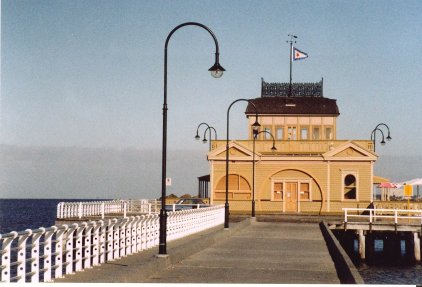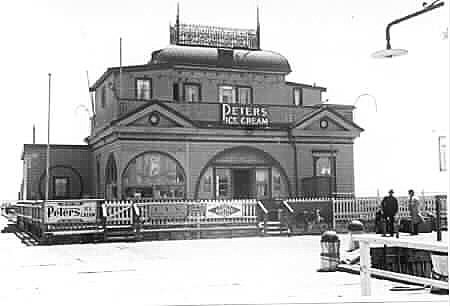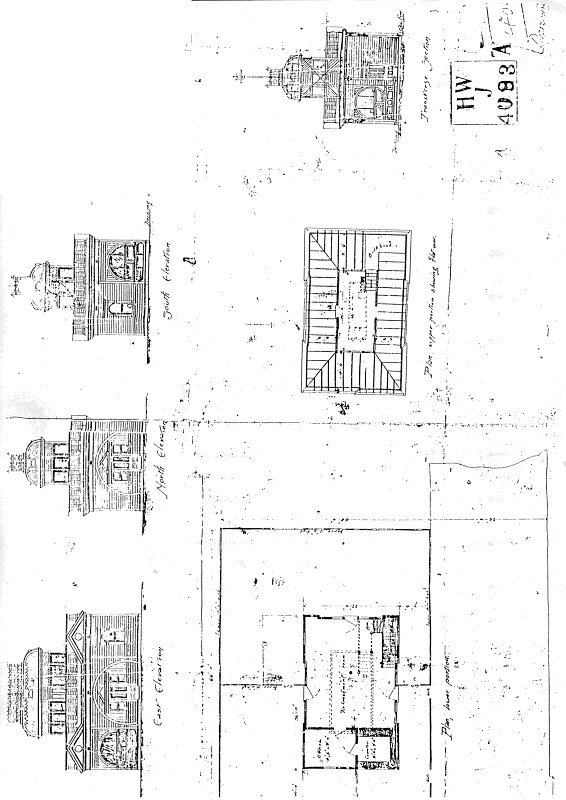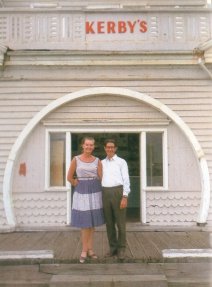|
|
|
Home | Introduction | Contents| Feedback | Map | Sources | Glossary |
|
1
In 1853, the St Kilda Pier and Jetty Company
was formed to profit from pier fees exacted from users of the Pier, which
presumably already existed. Firewood from the open woodland of St Kilda and
beyond could be shipped to
An early morning shot of the St Kilda Kiosk
In 1874, funds were provided for a breakwater and in 1883-84 the pier was extended. In 1899 the pier was again extended to 700 metres with 61-metre L-shaped ‘breakwater’, at which glamorous Port Phillip excursion steamers such as the Ozone, Hygeia and Weerona berthed until 1949 (48). The St Kilda Council Foreshore Committee files include correspondence between the Council, the Bay Excursion Company, Huddart Parker and the Melbourne and Tramways Omnibus Company regarding their potential loss of business due to the steamers.
Whilst Port Melbourne’s and most of
Williamstown’s piers are for commercial or naval use, St Kilda’s pier has always
been a pleasure promenade, and solely for this after construction of bridges
across the Yarra from 1850. If
Red carpeted, with military guards of honour and performing schoolchildren flag-waving on cue, the Pier officiated not only as the civic, but the national, the point of arrival for visiting royalty and other dignitaries. The Duke and Duchess of Cornwall and York (later King George V and Queen Mary) landed there in 1901, to then grandly process down St Kilda Road to the Royal Exhibition Building to open Australia’s first Federal Parliament. Great enjoyment was afforded the many thirsty souls who paid a visit to the Pavilion at the end of the pier. Mr Francis Parer, the popular caterer had evidently foreseen the rise of the mercury and laid himself out to provide the pleasant cooling creature comforts so much in demand on a hot day by picnickers. The fame of the pavilion is growing and justly so, for nowhere can more enjoyable peaceful happiness be secured at St Kilda than by lounging restfully on the broad balcony of this pleasure place...
So purred the St Kilda Advertiser on
...go aloft to the spacious circular balcony ... At night, the view shorewards resembles a fairy scene. The many lights are glowing ... The picture formed is truly a notable sight. Splendid and multifarious and Edwardian amusement piers frequently adorn English seaside resorts, and several still survive and thrive. In 1886 Henry Woodall planned to erect an ornamental pier almost half a kilometre out from the Upper Esplanade, with newspaper and fruit kiosks culminating in entertainment and refreshment rooms for 1000 people. It never happened.
An Edwardian amusement pier was built and
survives; much altered, at Manly,
Midway along the pier at
St Kilda’s, by comparison a tiny kiosk, a
unique and much-loved seaside building to Melburnians, was only one of many such
quirky Edwardian establishments for refreshment and amusement on the St Kilda
foreshore, erected around 1900-14 and depicted in postcard views. Local myth is
that it is only one of three identical pavilions built by Mr Parer to survive.
The kiosk was emulated in
St Kilda Kiosk, 1950
Like many clients, Francis Parer (1860-1935),
caterer claimed in family correspondence to have designed the kiosk himself. He
was certainly the entrepreneur driving the proposal. He was a member of a
successful floor milling and hospitality family who had first emigrated from
Francis came out from
Morell remained employed at the PWD. In 1913
he had become interested in the new discipline of Town Planning (31 &
35) and was sent overseas, and met Raymond Urwin, the father of town
planning. Morell wrote a report on developments in slum clearance, civic
beautification, garden suburbs and cities on the American model as seen in
The surviving architectural tender drawing also indicates that John W. Douglas was the builder. He was a showcase-maker, shop and office fitter of 315A Block Place, Melbourne. This would account for the fancy joinery details in the kiosk building. The structure of the curious timber pavilion is unusual. Located at the end of the 457 metre pier, the pavilion rested not on the pier, but on 60 piles, driven into the seabed and supporting the 20 x 14.6 metre decking, onto which the 11 x 6.7 metre building was bolted, allowing a wide ‘promenade’ around, for tables and chairs. At ground level was a ‘refreshment’ (or concert) room with a small office and shop. Stairs climbed to the first floor which forms a 5.7 x 2.7 metre observatory and up again to a widow’s walk around the flagpole surmounted by a weathervane. The kiosk was located to one side on the L-wing of the pier, rather than on axis, to where it was relocated when the pier was rebuilt in 1970. The St Kilda Advertiser described the architectural style as ‘oriental’. It noted the Muranese glass (which survived until 2003) in the outer windows on each side, the plain and fancy weatherboards with embellishments of fancy scalloped scrolls and woodwork. It also recorded the robust dimensions of the members necessary in such an exposed position and the iron pillars supporting the ‘roof promenade’ from which the ‘wonderful panorama of the metropolis’ can be viewed. The design, despite its reputation for quirkiness, is actually sedate and symmetrical French Empire Classicism, in the tradition of William Pitt’s (33) 1886-87 design for the Princess’ Theatre, Spring Street, with its flanking pediments, round mansard roof and widow’s walk. Its only eccentricity, two apparently Moorish horse-shoe arches, were actually relatively common in Federation domestic design. Those at the kiosk were actually circular, rather than horse-shoe shaped anyway. In 1982, Helen Garner fancifully and mythically described the kiosk’s ‘nautically scalloped weatherboards’ and ‘onion shaped curve outlining its front door’. Francis Parer operated the kiosk on a government lease for about 30 years, well into the 1930s. He soon decided to live in the kiosk itself, giving his address as ‘St Kilda Pier Pavilion’. He ‘offered fish and fruit luncheons, without any intoxicating liquors of any sort!’ Parer’s Pavilion as it was popularly known was actually named the Austral Refreshment Rooms. The pavilion enjoys, under the Commonwealth Meteorological Bureau, a semi-official status... Mr Parer is an enthusiast in weather lore... Flags are showing what the weather forecast for the day is, and these flags are hoisted from information received each morning from the office of Mr M.A. Hunt, the Commonwealth Meteorologist.
There have since been many straggling additions and alterations to the original design, which had been continuously altered since 1908, when Parer added to the rear.
Original Drawings for the St Kilda Pier, c.1913
The popular annual St Kilda by the Sea,
Mr Noble and Mrs Ivy Kerby acquired the lease from the Victorian Government in 1939. Their son Colin (1921- ) had worked there since 1934, as a young boy. Kerby operated the kiosk in the pavilion for 18 years. Mr Kerby’s performing seals are remembered. During World War II, a dance deck with a polished steel floor was erected over the first floor balcony. Dances were held there on Sunday afternoons. Many remember being taught to jitterbug by American servicemen at Kerby’s.
Sidney Nolan (1917-92) whilst painting his
famous first Ned Kelly series at Heide, Bulleen in 1945, also completed Under
the Pier, St Kilda (also known as: Playing under the Jetty, St Kilda),
recalling memories of growing up in St Kilda. How many boys lay under the pier
and gazed up the dresses of the girls promenading overhead? The Nolan family
lived at
A new breakwater was built in 1956 for the
Melbourne Olympiad (33) when the yachting events were held on
The pavilion was to be renovated within the St Kilda Tourism Development Plan funded by a million dollar Bicentennial Grant. The plan was to redevelop the area of the pier as far as West Beach at Fraser Street, including: a boat harbour, the Alma Doepel Sea Base, relocation of the Royal Melbourne Yacht Squadron and a harbour village development. The capital cost was to be $32.5 million with construction over 1986-98.
A far more sensible and less intrusive
proposal arose when Mirka Mora (17) was commissioned to create a mosaic
at the end of the pier. It became a ‘kind of map of St Kilda,’ said Mirka. ‘It
was part of the view from my house in
The pier’s maintenance is the responsibility of Parks Victoria, who oversaw large development works there over the two years 2000-02. They report that 2.5 million visit St Kilda Pier each year.
The St Kilda Pier kiosk was totally destroyed
by fire on
Allom Lovell Pty Ltd’s tender to ‘re-construct
the kiosk as per the 1904 drawings and construct a single-story dining facility
to the west of the kiosk building’ was accepted on
In the light of the history of invariable destruction by exposure to extreme weather, of piers elsewhere and by fire of other St Kilda public and foreshore entertainment buildings, it is perhaps surprising that the St Kilda Pier Kiosk survived at all for almost a century.
Note: This chapter was originally completed in August 2002, over a year prior to the kiosk’s destruction by fire. It has not been substantially re-written, but rather, its subsequent story has been very briefly summarised.
References
Abell, Lesley.
‘Profits and Pavilions: late nineteenth century and early twentieth century
plans of South Australian and Victorian Piers’. Journal of the Historical
Society of
City of
Crawford, Anne.
‘Down by the pier.
Davison. Graeme
(ed).
Fooke, Maggie. Pleasure Domes. 1980s [film]
Freestone, Robert.
Garner. Helen.
The Age
Inglis,
A. Beside the
Kellaway,
Dr C. National trust Research Notes,
Lewis, Prof. Miles. ‘Australian Architectural Index’. For Morell.
Milletic,
Dianella. ‘Life and death at pier’s end’. The Age
Moloney, David. St Kilda Pier Kiosk. Conservation Management Plan prepared for Parks Victoria. April 2004. Includes extensive biographical research on Morell and Parer. Moloney gives variously Parer’s death as’4 October 1935’, operating the kiosk’ into the 1930s’ and ‘1925’, with lessees until the Kerbys, including an entirely non-military ‘Major Payne’. Mora Mirka Mirka Mora. Wicked but Virtuous. My Life. Viking. Ringwood 2000. pp242-244.
Morell, J.C. Town
Planning. Report to the Honourable The Minister for Public Works. Government
Printer, Melbourne.
Mulhall, Lisa. ‘Realm of the pier…’ Weekend Herald. 13-14 December 1986 p11.
National Trust of
Nolan,
Parer, Michael. Family History Archive. Letter from ‘MC’ quoted by Moloney, p36. Register of the National Estate. Place ID: 15024.
Heritage
St Kilda by the Sea. 1913 and 1915-16.
St
St Kilda Advertiser,
24 September, 12
October and
State Library of
Trethowan,
Bruce. “The Public Works Department of
Wells, Lana.
Sunny Memories. Australiana at the
|
|
St Kilda Historical Society Inc. © 2005 |




